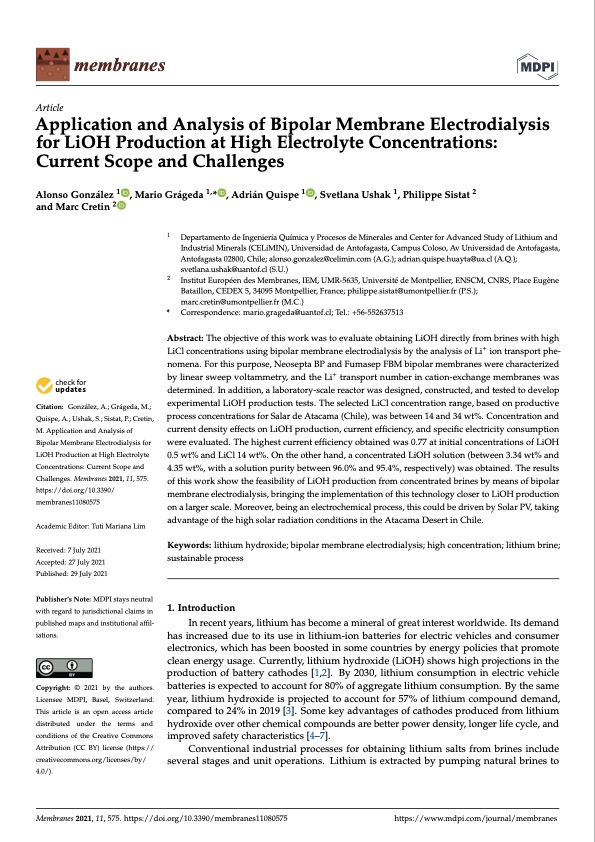
PDF Publication Title:
Text from PDF Page: 001
membranes Article Application and Analysis of Bipolar Membrane Electrodialysis for LiOH Production at High Electrolyte Concentrations: Current Scope and Challenges Alonso González 1 and Marc Cretin 2 , Mario Grágeda 1,* , Adrián Quispe 1 , Svetlana Ushak 1, Philippe Sistat 2 Citation: González,A.;Grágeda,M.; Quispe, A.; Ushak, S.; Sistat, P.; Cretin, M. Application and Analysis of Bipolar Membrane Electrodialysis for LiOH Production at High Electrolyte Concentrations: Current Scope and Challenges. Membranes 2021, 11, 575. https://doi.org/10.3390/ membranes11080575 Academic Editor: Tuti Mariana Lim Received: 7 July 2021 Accepted: 27 July 2021 Published: 29 July 2021 Publisher’s Note: MDPI stays neutral with regard to jurisdictional claims in published maps and institutional affil- iations. Copyright: © 2021 by the authors. Licensee MDPI, Basel, Switzerland. This article is an open access article distributed under the terms and conditions of the Creative Commons Attribution (CC BY) license (https:// creativecommons.org/licenses/by/ 4.0/). 1 2 * Correspondence: mario.grageda@uantof.cl; Tel.: +56-552637513 Abstract: The objective of this work was to evaluate obtaining LiOH directly from brines with high LiCl concentrations using bipolar membrane electrodialysis by the analysis of Li+ ion transport phe- nomena. For this purpose, Neosepta BP and Fumasep FBM bipolar membranes were characterized by linear sweep voltammetry, and the Li+ transport number in cation-exchange membranes was determined. In addition, a laboratory-scale reactor was designed, constructed, and tested to develop experimental LiOH production tests. The selected LiCl concentration range, based on productive process concentrations for Salar de Atacama (Chile), was between 14 and 34 wt%. Concentration and current density effects on LiOH production, current efficiency, and specific electricity consumption were evaluated. The highest current efficiency obtained was 0.77 at initial concentrations of LiOH 0.5 wt% and LiCl 14 wt%. On the other hand, a concentrated LiOH solution (between 3.34 wt% and 4.35 wt%, with a solution purity between 96.0% and 95.4%, respectively) was obtained. The results of this work show the feasibility of LiOH production from concentrated brines by means of bipolar membrane electrodialysis, bringing the implementation of this technology closer to LiOH production on a larger scale. Moreover, being an electrochemical process, this could be driven by Solar PV, taking advantage of the high solar radiation conditions in the Atacama Desert in Chile. Keywords: lithium hydroxide; bipolar membrane electrodialysis; high concentration; lithium brine; sustainable process 1. Introduction In recent years, lithium has become a mineral of great interest worldwide. Its demand has increased due to its use in lithium-ion batteries for electric vehicles and consumer electronics, which has been boosted in some countries by energy policies that promote clean energy usage. Currently, lithium hydroxide (LiOH) shows high projections in the production of battery cathodes [1,2]. By 2030, lithium consumption in electric vehicle batteries is expected to account for 80% of aggregate lithium consumption. By the same year, lithium hydroxide is projected to account for 57% of lithium compound demand, compared to 24% in 2019 [3]. Some key advantages of cathodes produced from lithium hydroxide over other chemical compounds are better power density, longer life cycle, and improved safety characteristics [4–7]. Conventional industrial processes for obtaining lithium salts from brines include several stages and unit operations. Lithium is extracted by pumping natural brines to Departamento de Ingeniería Química y Procesos de Minerales and Center for Advanced Study of Lithium and Industrial Minerals (CELiMIN), Universidad de Antofagasta, Campus Coloso, Av Universidad de Antofagasta, Antofagasta 02800, Chile; alonso.gonzalez@celimin.com (A.G.); adrian.quispe.huayta@ua.cl (A.Q.); svetlana.ushak@uantof.cl (S.U.) Institut Européen des Membranes, IEM, UMR-5635, Université de Montpellier, ENSCM, CNRS, Place Eugène Bataillon, CEDEX 5, 34095 Montpellier, France; philippe.sistat@umontpellier.fr (P.S.); marc.cretin@umontpellier.fr (M.C.) Membranes 2021, 11, 575. https://doi.org/10.3390/membranes11080575 https://www.mdpi.com/journal/membranesPDF Image | Bipolar Membrane Electrodialysis for LiOH Production

PDF Search Title:
Bipolar Membrane Electrodialysis for LiOH ProductionOriginal File Name Searched:
membranes-11-00575-v2.pdfDIY PDF Search: Google It | Yahoo | Bing
Product and Development Focus for Infinity Turbine
ORC Waste Heat Turbine and ORC System Build Plans: All turbine plans are $10,000 each. This allows you to build a system and then consider licensing for production after you have completed and tested a unit.Redox Flow Battery Technology: With the advent of the new USA tax credits for producing and selling batteries ($35/kW) we are focussing on a simple flow battery using shipping containers as the modular electrolyte storage units with tax credits up to $140,000 per system. Our main focus is on the salt battery. This battery can be used for both thermal and electrical storage applications. We call it the Cogeneration Battery or Cogen Battery. One project is converting salt (brine) based water conditioners to simultaneously produce power. In addition, there are many opportunities to extract Lithium from brine (salt lakes, groundwater, and producer water).Salt water or brine are huge sources for lithium. Most of the worlds lithium is acquired from a brine source. It's even in seawater in a low concentration. Brine is also a byproduct of huge powerplants, which can now use that as an electrolyte and a huge flow battery (which allows storage at the source).We welcome any business and equipment inquiries, as well as licensing our turbines for manufacturing.| CONTACT TEL: 608-238-6001 Email: greg@infinityturbine.com | RSS | AMP |